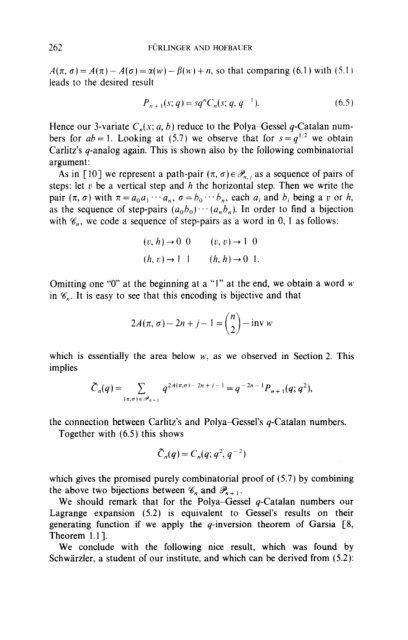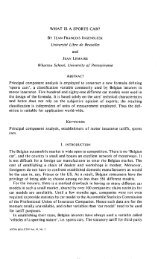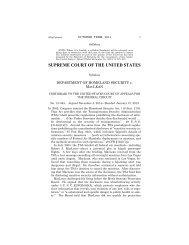85jct_catalan
Create successful ePaper yourself
Turn your PDF publications into a flip-book with our unique Google optimized e-Paper software.
262 FijRLINGE:R AND HOFBAUER<br />
A(rr, a)=A(n)-A(cr)=u(w)-fi(+~)+n, so that comparing (6.1) with (5.1)<br />
leads to the desired result<br />
p,, + ,(K 9) = ~q”c,l(.c q, q ’ ). (6.5)<br />
Hence our 3-variate C,,(x; a, b) reduce to the Polya-Gessei q-Catalan numbers<br />
for ab = 1. Looking at (5.7) we observe that for s = q’,!2 we obtain<br />
Carlitz’s q-analog again. This is shown also by the following combinatorial<br />
argument:<br />
As in [lo] we represent a path-pair (rr, a) E Yn., as a sequence of pairs of<br />
steps: let v be a vertical step and h the horizontal step. Then we write the<br />
pair (n, cr) with ~=a,a, .“a,,, a = b, . . b,, each ai and hi being a v or h,<br />
as the sequence of step-pairs (a,b,) ‘.. (a,b,). In order to find a bijection<br />
with g,;,, we code a sequence of step-pairs as a word in 0, I as follows:<br />
(v,h)-tO 0 (v, v) -+ 1 0<br />
(h,v)+l 1 (h,h)+O 1.<br />
Omitting one “0” at the beginning at a “1” at the end, we obtain a word u<br />
in V,,. It is easy to see that this encoding is bijective and that<br />
2A(7c, a)-2n+i- 1= ‘;<br />
0<br />
- inv u’<br />
which is essentially the area below w, as we observed in Section 2. This<br />
implies<br />
the connection between Carlitz’s and Polya-Gessel’s q-Catalan numbers.<br />
Together with (6.5) this shows<br />
C(4) = C,(q; Y2, q *I<br />
which gives the promised purely combinatorial proof of (5.7) by combining<br />
the above two bijections between %‘R and gn+, .<br />
We should remark that for the Polya-Gessel q-Catalan numbers our<br />
Lagrange expansion (5.2) is equivalent to Gessel’s results on their<br />
generating function if we apply the q-inversion theorem of Garsia ES,<br />
Theorem 1.11.<br />
We conclude with the following nice result, which was found by<br />
Schwarzler, a student of our institute, and which can be derived from (5.2):





